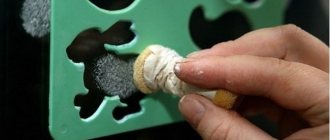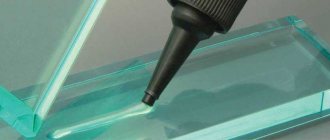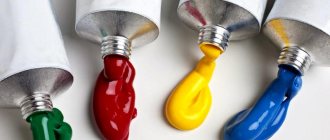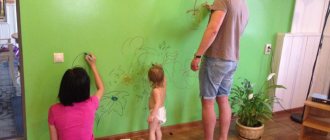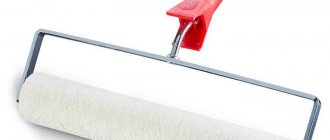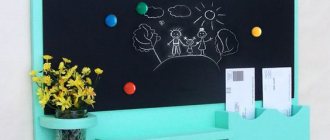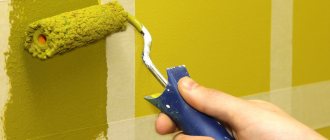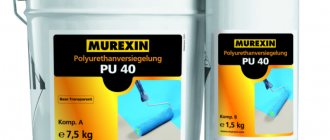Features and characteristics of stained glass paint
Stained glass compositions are paints and varnishes intended for application to a smooth surface - glass, mirror, ceramic or plastic. Using specialized paints, professional artists skillfully decorate the room, creating a spiritual atmosphere in the house:
- paint window and door openings;
- decorate ceilings and partitions with drawings to separate and zone rooms;
- transform wardrobes, mirrors and wall clocks.
Fans of artistic painting paint landscapes and still lifes, zodiac symbols and hieroglyphs, and create ornamental motifs and storylines. They paint ceramic plates, glassware (glasses, wine glasses, vases) and even aquariums. The decorated item can be placed indoors or given as a holiday gift to close relatives and friends.
Stained glass paintings are individual, creative, and have a special, original style. When exposed to sunlight or artificial light, they shimmer in different shades, creating a unique effect.
From polymer clay and stained glass paints, some craftsmen create textured rings, beads or shaped items for bracelets and earrings, magnets, keychains and frames for children's and adult photographs.
Paints for glass and other smooth surfaces are resistant to ultraviolet radiation, temperature changes, atmospheric conditions, and do not wear off or fade over time when applied correctly and with high quality. You can buy them at a stationery store at affordable prices or make them yourself at home using scrap materials.
Stained glass works can be glued to windows.
Types of coloring compositions
Stained glass paints for glass differ from each other:
- composition;
- consistency;
- texture;
- color scheme;
- method of application to the surface;
- drying time.
Depending on the type of solvent, several main groups are distinguished.
Water based
Paintwork materials do not have a strong odor and do not streak. They have a liquid consistency, are hypoallergenic, transparent and environmentally friendly, do not harm the artist’s health during the creative process, and do not contain dangerous additives. Acrylic is present in small concentrations.
But there are also disadvantages:
- The compositions do not have bright colors and tone saturation.
- Can be washed off with water immediately after application.
- Over time they can fade. It depends on the chosen brand and manufacturer.
Water-based stained glass paint is most suitable for children, pregnant women and allergy sufferers. With this material you can draw snowflakes on windows before the New Year holidays, decorate plates, small vases, glass glasses, goblets and wine glasses.
The finished product must be baked at high temperatures, otherwise its service life will be short.
Alcohol compositions
Stained glass alcohol-containing paint is suitable for treating smooth surfaces. It is liquid and spreads when poured, but is quite convenient to use and resistant to external influences.
Alcohol-based formulations:
- have a wide palette of colors;
- add brightness and shine to images;
- applied with a brush;
- washed off with special solvents;
- do not require firing in the oven.
Acrylic stained glass paints
They are a type of water-based paint and have richer tones. When mixing different colors on glass, beautiful shades are obtained, no different from those applied by the artist with strokes on canvas or cardboard paper.
The product is not afraid of direct sunlight, humidity, and temperature fluctuations.
It dries quickly:
- after 3-4 hours it stops sticking to your hands;
- After a day, the product is ready for use; it can be wiped with a damp sponge or washed.
The painted composition does not require firing in an oven, but to increase the wear resistance of the composition, a layer of acrylic varnish should be applied on top.
Acrylic paints are one of the varieties.
Varnish coatings
They are also called solvent. They are created on the basis of organic resins and are diluted only with special solvents.
Varnish paints are used for:
- decorative design of building signs, walls, windows, doors, mirrors;
- furniture painting;
- painting on canvas or glass;
- performing artistic works in mixed media;
- painting glass, plastic or porcelain objects.
Material:
- has good adhesive properties;
- spreads evenly over the surface;
- after pouring does not require additional heat treatment;
- does not wash off;
- does not wash off;
- does not crumble.
After complete drying, which lasts for at least 10 days, the coating is even, smooth and durable, the image becomes clear and original. During the first 3 days, it is not recommended to touch the painted object with your hands.
The main disadvantage is the unpleasant odor emanating from the solvent. When working with the substance for a long time, susceptible people begin to feel unwell and may have an allergic reaction to varnish paint. Therefore, you need to wear a respirator and ventilate the room.
Other types
Glass paints come in the following types:
- Sticky. Water-based or acrylic. Colors can be mixed to create new shades. How to use the product:
- attach a transparent vinyl film to the stencil;
- outline the image;
- paint a pattern inside a limited area;
- wait until the material dries;
- separate the drawing from the film;
- stick to the surface.
- Silicate. They are evenly distributed over the coating, creating a shiny, smooth layer that does not crack when dry. During firing, sintering occurs with the glass; after heat treatment, the painting becomes matte, durable and resistant to external factors.
- Chandeliers. The main feature is the presence of a metallic sheen.
- Foaming (volumetric). During firing, the coating delaminates, visually increasing the volume several times. It is enough to dry the stained glass with a hairdryer or keep it in the microwave for 30 seconds.
- Granular. When baked in the oven, the paint spreads, forming small bubbles on the item being decorated.
- Mother of pearl. They are transparent, applied as an additional layer on top of the base layer to give a radiant effect.
- With additives. Loose glitter in the form of stars, hearts, and flowers is added to paintwork materials for deep shimmer and volume.
- Matting. The paint is translucent and has a delicate pastel tone.
- Crystal. They have a light shade, a little cloudy. After drying, the material becomes invisible, but when sunlight hits the stained glass window, it shimmers with rainbow tones.
- Marble. Imitates the matte finish of the treated surface.
- Craquelure. The effect of small cracks is created, which gives the decorated product a romantic look of antiquity.
- Relief (contour). They are applied to determine the drawing area and create boundaries and relief on the product.
- Pearl. Using paint squeezed out of a tube, pearls of different sizes are formed.
- Liquid enamel. Before working with the material, water is first applied to the surface, then patterns are made using enamel.
- Structural. A paste-like substance, when applied, an unusual structure is formed. For example, the finishing layer is made of stone or leather.
Decorative glass painting
The first drawings and ornaments that a novice artist applies to a glass surface should not be too complex. If a child is drawing, you can invite him to depict a flower, a butterfly, decorate the product with clouds and the sun, draw rain, etc.
Making simple strokes and lines will also help an adult who has never done drawing before. You can use contour drawings as a template by placing the template under clear or frosted glass. Having outlined the dark lines, the middle is painted over with a single tone.
Technique
For glass painting, similar techniques are used:
- simple contour filling;
- Tiffany - creating a continuous pattern from individual elements, each of which looks like a piece of a mosaic;
- stained glass painting - done with special paints (transparent), each part of the picture is a dark outline filled with 1 tone.
The work begins with preparing the glass. For your first experiments, you can paint a glass jar, turning it into a vase. To easily remove the label from the product, you need to soak it in warm water with detergent. The container is then washed and dried.
If a flat glass plate is used, then after removing the dust with a dry cloth, you can simply treat the surface with alcohol or vodka, glass cleaner, and wipe until dry.
For painting, it is better to choose high-quality paints, for example, from Olki or Decola.
Prepare for painting:
- paints and palette;
- several brushes (one for each shade);
- stick or spatula for mixing paints;
- solvent containing acetone;
- acrylic clear varnish.
The prepared base is painted in the following order:
- Using a thin brush, apply the contours of the design, placing the sketch on paper under the plate. If the Tiffany technique is chosen, small rounded contours are drawn that make up a large detail of the painting (for example, the background). The elements of the design can be whole, if they are small (petal of a small flower, etc.), their shape can be any. When all the contours are drawn, the product is left to dry for the period specified by the paint manufacturer. If a volumetric outline was used (draw it without a brush, squeezing a strip out of the tube), you need to completely dry it before painting.
- Fill the inside of the outline with paint of the desired shade. When painting in the Tiffany style, you can make 2-3 strokes in different shades of color in 1 mosaic element. This will give the drawing expressiveness and create a volume effect. For stained glass, the inside of the contour is filled with 1 shade. If you are painting an object with a shadow, make several strokes with a darker shade of the paint with which the element is filled.
- The finished product is dried and varnished. To make the design even more resistant to moisture during cleaning, the product can be heated in the oven. The glass object is placed in a cold cabinet, and then it is turned on, the temperature is brought to +150°C, it is turned off and the glass is left to cool in the oven.
What other types of stained glass paints are there?
Glass paints are divided into 2 groups depending on subsequent processing:
- fired;
- unfired.
Burnt
The compositions are purchased in specialized stores. The container bears a label with the inscription Porcelain or Porzellan.
Products with paint applied to glass must be thermally baked in an oven or oven. The firing temperature varies from +120°C to +180°C, the duration of the procedure is from 30 minutes to 1.5 hours. The parameters depend on the characteristics of the paintwork material, brand and manufacturer.
Main advantages:
- high strength;
- uniformity of coating application;
- contains water, so brushes can be washed without solvents;
- no smell.
The disadvantage is that after drying in the oven, the colored areas become opaque, matte and slightly cloudy. After heat treatment of glasses or wine glasses, the back wall of the product cannot be seen.
Unfired
Such compositions are widely in demand due to their simplicity and ease of use. They have beautiful tones and form a durable, indelible film. Paints use a solvent. Drying time is at least 3 weeks at room temperature.
After hardening, the coating can be washed without special products or pre-soaking. If you need to erase a drawing, use a solvent.
Disadvantages of working at home with burnt paints
Firing is best done in special kilns. Artists do not always have the opportunity to organize the procedure at home. In addition, professionals who know how to correctly carry out the procedure should work with paintwork materials subjected to heat treatment. During the process, you should be careful not to get burned yourself or injure your loved ones.
Unfired set of stained glass windows.
Glass painting: where to start?
If you decide to try yourself in this type of painting, then you should listen to our recommendations. They will simplify the work and bring more pleasure from the final result. First of all, you need to choose transparent dishes, window glass or ceramics in light colors, without a pattern. This is important, because a drawing, even a small one, will distract you from your work.
At the beginning of the creative process, it is better to make a sketch of the intended drawing on paper. This will make your work easier, and then, with experience, your hand will remember the technique of drawing this sketch, and everything will start to work out much faster.
When you decide to paint with acrylic paints with more complex designs, first apply the sketch you like onto paper. After drawing it several times, you will be much more confident and accurate when applying it to glass or ceramics. It can be difficult to immediately make transitions from a thin line to a bolder one and back, but practicing on paper will help avoid sloppiness directly on the product.
To draw flowers, even simple ones, it is also advisable to practice on paper. It just seems that drawing flower petals is easy. When you start moving on to complex things, try inserting flowers into a ready-made ornament. This process is very exciting.
It is also important that drawing, in which paints are used for painting on glass, ceramics and glassware, develops imagination and seems to transport the master into his own world. It calms you down and helps you forget about troubles. The brain switches to positive emotions, takes the person mentally to where he felt good. When the work is finished and you have to return to real life, solving difficult life problems does not seem impossible.
If you are still in doubt where to even start, then you can find a huge number of master classes on the Internet. From them you will learn how to hold a brush correctly, they will help you decide on your first drawing. In this article you can also watch one of these video tutorials.
If you paint on glass and you didn’t manage to get a subtle pattern the first time, don’t despair! Experience does not come immediately. Don't give up and try to paint a glass piece with your family members. Such drawing will bring pleasure to everyone, and the memories of the time spent together will last a lifetime.
Selection of stained glass paints
Paint for working with glass surfaces is selected depending on individual preferences, the level of skill of the designer, and the purpose of decoration.
If you need to create a beautiful picture on a glass or fabric base, or paint a large showcase or doorway, use varnish enamels.
For beginners who are just starting their creative journey, decorating with water and acrylic compositions is recommended.
When are acrylic compounds best suited?
Acrylic is very popular among arts and crafts enthusiasts. It will suit:
- For children. The paint is safe and non-aggressive. It is used during painting training.
- For temporary application. The product is easily washed off with water and thinners, and is used to decorate the room before special events and events. Apply to windows, doors, shop windows.
- For artistic decoration of small items - dishes, bottles, sets. The products are decorated with interesting motifs and ornaments, and congratulations are written on them. For painting use wide and thin brushes.
- For processing large surfaces. Purchase branded paints in aerosol cans. To avoid drips and other defects, strictly follow the instructions on the label when spraying. During work they use personal protective equipment.
Features of application to glass
You can apply paint to a glass product in the following ways:
- By dipping. The object is dipped into the dye bath and then removed. Excess liquid drains off, leaving the coating in the form of a thin film.
- With a roller. The easiest way to paint large glass areas in a single color. The roller is passed repeatedly, resulting in a uniform and homogeneous layer.
- With a brush. Used to fill limited spaces and apply color spots. The patterns are multi-colored, multifaceted and beautiful.
- Spray with a spray gun or aerosol can. Large panels are painted. The work is done easily and in a short period of time.
Technological features of applying a pattern on a smooth coating:
- Before work, buy paints. For beginning artists, non-fired compositions are suitable.
- Prepare all tools and consumables. The absence of at least 1 component will negatively affect the result.
- Be sure to choose a pattern, copy it on the Internet or take it from any coloring book, and make a sketch. You can use a ready-made template, which you can purchase at an art or construction store.
- Degrease the surface to be treated. Greasy human fingerprints often remain on dishes and should be removed. Alcohol is used for these purposes.
- Inside the dish, attach or tape a stencil or a hand-made sketch to the glass.
- On the outside, using a marker or felt-tip pen, draw the outline of the image.
- Outline each area with contour paint, connect the ends of the lines so that there are no breaks, and subsequently the liquid does not leak out.
- Let dry.
If painting on glass is done with acrylic, contour lines may not be drawn. Without outlines, the pattern will look like a work of art made with your own hands; when applying relief borders, it will look like a stained glass window.
The main stage is painting the colored areas. The paint is applied using the drop method, then with a brush the substance is distributed over the surface from the center to the periphery in a thick stroke. Manipulations are performed first with one color, all corresponding areas are painted, then the dye is washed off from the paint brush, wiped it and moved on to another shade.
Paint application process.
Glass coloring technology
Before decorating a ceramic surface or glass object, the area must be degreased. Scheme of subsequent work:
- contour stained glass paint is applied carefully without smearing or drips;
- wait until the contour dries;
- paint stained glass with a brush or sponge;
- the voids that appear should be painted over with another layer;
- wait until the painting dries.
Application of acrylic coating
When using acrylic paints, the outline does not need to be formed. If necessary, it is applied after the painting is completely ready. The lack of outline in a drawing with acrylic paints is more reminiscent of painting on glass.
Use of balloon covers
You can paint the glass with an aerosol can if the area to be treated is quite large.
This product may have an oil, latex, acrylic base. Spray cans with acrylic paint are in great demand among consumers. Sprays are characterized by good adhesion, as well as the ability to paint hard-to-reach areas. Professionals often use balloon coatings to outline small details. Such products are sold in a wide variety of colors and dry quite quickly.
Application of a fixative
No matter what paints the master uses and no matter how many layers he applies to the glass, after drying the painting must be fixed. In this case, varnish is considered a universal fixative. It can also be used to cover a surface with a porous structure before painting begins. This will make the paint easier to apply.
The best manufacturers of stained glass paints
Among the wide range of paints and varnishes on the market, compositions from the following brands are suitable for glass painting:
- Lefranc&Bourgeois (France). They are available in 22 colors and 2 mediums (craquelure and matte). Packaged in 50 ml jars. With prolonged use they tend to dry out and thicken. Solvent based paints. The coating is smooth and glossy. It has good adhesion to metal, glass, and tiles.
- Pebeo (France). The manufacturer produces 4 series (3 main and 1 additional) for glass coloring:
- Vitrail – a palette of 26 intense solvent-based colors that do not require firing, sold in 45 and 250 ml bottles;
- Vitrea 160 – 30 shades from transparent to moiré and matte, 10 – embossed with frost effect in tubes, created on a water basis, hardening at a temperature of +160°C is required;
- Porcelaine 150 – 46 bright, transparent and matte colors, sold in 45 ml containers, applied to glass, porcelain and ceramic surfaces, mandatory baking at +150°C;
- Touch Deco - to add volume and achieve a metallic, pearlescent or antique effect.
- Marabu (Germany). The compositions are transparent, homogeneous, of good quality, and spread easily over the base coating. They do not require fixation by baking. You can buy it in a small container (15 ml) at a low price, which is profitable and convenient for artists who decorate small compositions.
The best contour manufacturers:
- Decola;
- "Tair";
- Pebeo;
- Lefranc&Bourgeois;
- Hobby Line.
One of the best manufacturers is Decola.
Painting ceramic tiles
An example of acrylic painting on ceramic tiles.
For flat ceramic surfaces, you can use all of the above techniques, except stained glass and Tiffany. Most often, tiles are decorated using a stencil, creating the same pattern on each element of the apron or panel in the bathroom.
Interior decor in the style of shabby chic or Provence can also be done using decoupage, gluing a drawing on paper onto ceramics.
In order for it to fit neatly into the product and look like a painting, after drying, use a semi-damp sponge to treat the border between the paper and the tile, applying a rim of paint that fades as it moves away from the picture. The shade of the rim should match some color in the drawing. After drying, you need to coat the plate with varnish.
Ready-made sets
Experts in the field of stained glass art recommend that beginners purchase ready-made kits. It is better for novice decorators not to buy the main components and additional accessories for creativity separately; you can choose materials that do not match the parameters.
The standard ready-made kit includes:
- base with a contour applied;
- stained glass paints;
- palette knife or brush;
- color scheme.
Some kits contain sparkles or rhinestones, others include a clock mechanism with hands and pendants for making your own wall clock in stained glass style.
How to work with stained glass paints
Painting objects with painting materials is an art that does not require professional skills, but knowledge and experience will not hurt. Beginners can first use a simpler painting technique, then move on to complex execution options.
Types of stained glass techniques
In artistic representation, glass painting can be:
- Spot. The technique is old, but thanks to the simple application of enamel it has never gone out of fashion. Many decorative artists use it to decorate dishes. It consists of applying dots that do not touch each other in the form of a pattern or ornament on glass.
- Contour. Borders are drawn on the sketch and all fragments are painted over.
- Without contour. Paints of different colors are poured onto the coating, spread over it, mixing with each other and forming abstract designs.
- Multilayer. Layers are superimposed to form three-dimensional images.
Stained glass styles:
- Divorces. It is used for mixing different colors from the same manufacturer with a colorless composition and applying a liquid mass. The coating has a marble effect.
- Double stroke. If you want to get 2 shades in 1 stroke, dip the brush on one side in a dark color, on the other side in a light color, then make a stroke, alternately turning the tool.
- Ombre. Drawing is done with a sponge. The image is similar to Victorian plaster.
- Tiffany. The outline of the pattern is marked with a felt-tip pen, then the coloring agent is carefully applied. The surface is treated with varnish. The result is a 3D drawing.
- Gzhel. 2-color technique using white and blue enamel.
- Khokhloma. It is used for working with wood, but some craftsmen can also work with glass. Black, red and green patterns are made on a yellow background.
- Petrikovka. Spectacular and captivating: beautiful flowers, fabulous animals or birds are depicted in black or gilded form.
- Gorodets painting. The theme concerns rustic interiors and rural life. The compositions feature a hut, household items, villagers working in the fields, a forest, and berries. The picture is bordered with white or black color.
- Vanguard. Simple geometric patterns (squares, triangles), random lines, and blots are applied to the glass.
- Inscriptions. The simplest version. Painted symbols, hieroglyphs, and zodiac signs look fashionable and stylish. Beginners can paint names and words of congratulations on bowls and glasses.
Tools and consumables
For creativity you need:
- Paints. The color is chosen depending on the pattern and individual desires. Beginning craftsmen are recommended to purchase non-fired compositions. They are easier to work with.
- Contours for glass. They can be sold in sets or individually. The color range is wide. They are a thick mass in tubes with a thin tip. Designed for drawing outlines, creating relief, also used in dot painting.
- Marker or felt-tip pen for sketching patterns on the surface.
- Acrylic lacquer. Used to fix dye.
- A stencil, template, drawing or sketch applied to transparent glass.
- Water, thinner or solvent. Selected according to colors. The rules of use are located in the instructions on the label of the jar or tube.
- Acetone or alcohol. For degreasing glass coating.
- Cotton swabs and swabs. For wiping excess enamel from the surface being treated and wiping the brush.
- Needle or toothpick. To get rid of air bubbles that appear on the item being decorated.
- Palette. For mixing colors.
- Several types of artistic brushes.
- Oilcloth. To protect the workplace from ingress of coloring material.
Step-by-step instructions for painting stained glass
Drawing a pattern with acrylic paints on glass is carried out in the following sequence:
- Lay down newspaper or oilcloth so as not to stain the furniture you will have to work on.
- Take the sketch and put it on the table, place the glass on top. If a stencil is used, it is placed on the surface.
- Trace the outlines with a felt-tip pen.
- Apply special contour paint exactly along the lines, squeezing it out of the tube.
- Wait 30 minutes for it to dry.
- Take a palette, mix colors on it and get the desired shades.
- Apply paint to each outlined area.
- Remove shortcomings during the work process.
- Leave the product to dry completely at room temperature.
- Cover the product with acrylic varnish.
Additional recommendations
To get a high-quality and beautiful drawing, you should consider some nuances:
- Patterns on glass glasses and wine glasses should be applied on the outside. Do not let your lips touch the edges of the treated surface while drinking.
- When firing, the painted dishes are placed in a cold oven and gradually heated to the required level. Heat treatment time and temperature are indicated in the instructions for use. Objects with stained glass are left in the oven until completely cooled, then removed. Do not bring the temperature to too high, otherwise the enamel will turn brownish.
- If, as a result of creativity, errors and flaws are obtained, they are removed with a cotton swab or swab immediately, before the material dries.
- When bubbles filled with air appear on the coating, they are pierced with a toothpick or a sharp needle.
- You can speed up drying by blow drying.
- Containers with coloring compounds should not be kept open. They will quickly dry out and deteriorate. It’s better to take a palette and apply the product to it, mix colors and get new individual shades.
- Keep art brushes in water during creative work, otherwise the enamel on them will harden. The tool will become unusable. The paintwork materials will have to be cleaned with a solvent or thinner.
- After use, the container is not left in the room; it is thrown away unopened.
2 tips on how to remove glass paint from clothes:
- Safe, but not always feasible. Soak the dirty item in cold water for a day, and wash it with laundry soap the next day. Chunks of dye may fall off.
- Aggressive, but has a 100% cleaning result. To remove stains left after artistic activities, you need to take cotton wool and soak it well in acetone or a mixture of acetone and turpentine, then saturate the contaminated area with it and rub with ammonia until the dirt disappears.
Precautionary measures
Working with stained glass paint requires the decorative artist to take the following precautions:
- When using water-dispersed and acrylic compositions, work with gloves and a special apron, despite the hypoallergenic properties of the material.
- Before working with aerosols or enamels containing toxic solvents, wear personal protective equipment.
- If chemicals come into contact with your hands or eyes, rinse them with plenty of water; in case of complications, consult a doctor.
- Dry the treated products in a well-ventilated area.
- Store containers with dyes in a secluded place, inaccessible to children, away from sources of fire, heating and heating devices.
Precautions must be taken.
Precautions during operation
When painting on glass, the artist should follow the safety rules:
- wear gloves and an apron;
- use personal respiratory protection when using enamels with toxic solvents;
- If paint and varnish substance gets on your skin or eyes, you should immediately rinse the part of your body with water;
- Dry painted surfaces only in a well-ventilated area;
- containers with dyes should be stored in a dry, cool place, away from children, heaters and heating devices.
Making stained glass paints with your own hands
You can make paints and varnishes for painting glass yourself without extra costs from scrap materials, such as manicure polish or PVA glue.
Nail polish based
Making paint mixture is not a difficult task. High-quality dye is prepared from:
- BF-2 glue;
- nail polish;
- any water-based paint.
Pour the ingredients into the container in a 1:1 ratio and mix well. Dilute the composition with paint. To obtain the required color, use a pipette: add 1 drop of coloring agent to the thick mass and mix.
The resulting substance lies smoothly on the surface, dries quickly at room temperature, does not crack or crumble.
How to fix drawings on glass?
When you have finished painting on glass, your work should be secured. One of the best ways to preserve your work for a long time is to use acrylic varnish. It has several features:
- the varnish is fire-resistant and does not emit such a strong odor as other varnishes; it is easy to work with even in a small room;
- easy application, thanks to which even an inexperienced person can easily cope with this task;
- dries quickly, which saves the technician’s time;
- diluted with water, which is also important;
- when applied, it does not change the original color, therefore, the work retains its original appearance;
- affordable price (about 150 rubles for 50 ml);
- economical - one jar can be used many times.

